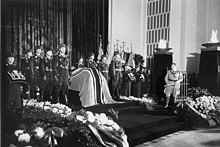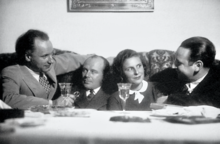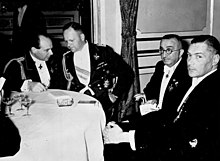Ernst Udet
Ernst Udet (born April 26, 1896 in Frankfurt am Main ; † November 17, 1941 in Berlin ) was a fighter pilot in the air force of the German Army during the First World War . After Manfred von Richthofen , he achieved the highest number of kills among German fighter pilots. After the First World War he was active in aerobatics and sightseeing flights. During the time of National Socialism , Udet was responsible for the technical equipment of the Air Force in the Reich Aviation Ministryand from 1939 held the post of general air master of the Wehrmacht , most recently with the rank of colonel general .
Life
Ernst Udet's parents were the engineer Adolf Udet and his wife Paula, née Krüger. He grew up in Munich, where he attended the elementary school in Stielerstraße and, from 1906, the Theresien-Gymnasium in Munich .
Udet got enthusiastic about the still young aviation from an early age . In 1909 he became a member of a model aircraft club , and in 1910 he attempted gliding . In addition, he worked in his father's boiler workshop and obtained his one-year certificate in 1913 .
Thanks to his flying skills, he was a star at many air shows of his time. No one except himself managed to pick up a handkerchief from the floor with the wing of his machine. Udet also promoted the career of the German record pilot Elly Beinhorn .
First World War
After his rather average performance in school, he volunteered in the military at the beginning of the First World War . After a short period as a motorcycle reporter in the 26th Reserve Division on the Western Front , he financed pilot training at the flight school of the Gustav Otto Flugmaschinenwerke in Munich. In April 1915 he acquired a civil pilot's license, which led to his being transferred to the Army Air Force. From June 1915 he served in the ground company of the Griesheim air replacement unit. In a two-seater, he flew observation flights over the western front until 1916 after completing his field pilot examination .

After several risky flight maneuvers and a crash, he suffered a nervous breakdown . In March 1916 he was transferred to the 206 artillery aviation division stationed near Kolmar in Alsace , which was equipped with Fokker E.III fighter planes.
After his third victory in the air on December 24, 1916, he was awarded the Iron Cross 1st Class . On January 22, 1917, Udet was made lieutenant in the reserve. On November 7, 1917 he was given command of Jagdstaffel 37 (Jasta 37), which he led until March 1918. In March he was requested by Manfred von Richthofen to lead the 11th squadron . In April 1918 he was awarded the Pour le Mérite .
After Richthofen fell, Udet took control of Jasta 4. In August 1918, he shot down 20 enemy planes. He scored his last two aerial victories a month later. Ernst Udet survived the war as first lieutenant and second most successful German fighter pilot; he was able to record a total of 62 kills for himself.
Weimar Republic

After the First World War, Udet earned his living with sightseeing flights and as a pilot for Rumpler Luftverkehr . In the summer of 1921, despite the restrictions of the Versailles Peace Treaty , he founded Udet Flugzeugbau GmbH with funds from the American financier William Pohl , which he left in 1925. Then he devoted himself more to art and exhibition flights, in which he often performed spectacular flight maneuvers. In 1925 he founded Udet-Werbeflug GmbH and in 1927 Udet Schleppschrift-GmbH. In 1929 Udet worked in the silent films of mountain film director Arnold Fanck The White Hell from Piz Palü and in 1930 in Storms over Mont Blanc as a mountain pilot. He got further film assignments from 1930 to 1932 in Fliehende Schatten , 1932/1933 in SOS Eisberg and 1935 in Wunder des Fliegens . He always played the savior in need who frees other people from dramatic situations through his flying skills.
Udet was able to attend the demonstration of the dive-ready Curtiss Hawk II in the United States in the early 1930s and managed to get the Air Force to finance the purchase of two copies for private use on the condition that they could be studied in detail after delivery. He was so impressed by the effectiveness of the dive bomber concept that he later postponed all bomber projects that were not suitable for dive combat.
Nazi dictatorship
In April 1933 he received the appointment of flying commodore of the German Air Sports Association , and on May 1, 1933 Udet joined the NSDAP . At Göring's instigation, Udet joined the newly established Air Force on June 1, 1935 with the rank of colonel . On September 1, 1935, he became inspector of the fighter and dive fighter pilots. As the successor to General Wimmer , he became head of the technical office of the Reich Aviation Ministry . He also organized sightseeing flights, among other things as part of the 1936 Olympic Games . On April 1, 1937, Ernst Udet was appointed major general and on November 1, 1938 promoted to lieutenant general. He is considered the inventor of Jericho Trumpet , a siren that the dive-bombers of the type Junkers Ju 87 gave ( "Stuka") on the steep nosedive a typical intimidating noise.
Second World War
Udet is considered to be partly responsible for the misguided German air armament during the first years of the war, which suffered mainly from its enormous inefficiency and the fact that the political objectives and the actual course of the war were completely contrary. On February 1, 1939, Göring gave him the new post of general air master . In this function Udet was subordinate to the State Secretary of the Reich Aviation Ministry and Inspector General of the Air Force Erhard Milch . This expanded the competence of the Technical Office, now headed by Udet, which was not only responsible for the entire aircraft development and production, but also for procurement, supplies and supply. If it was a wrong decision to let Udet head this office, this was all the more true now that Udet had trouble filling the position beforehand. From then on he was subordinate to 26 departments with 4,000 officers, civil servants and engineers who were responsible for everything, but not responsible for anything. The office of general air master meant a further curtailment of competencies for Erhard Milch, who stated with resignation: "Everything turns to dust in Udet's hands."
Udet became the plaything of the particular interests of Messerschmitt , Heinkel and Junkers , who repeatedly succeeded in getting him excited about their projects regardless of the actual benefits and costs, so that Udet did not adequately fulfill his actual task.
On July 19, 1940, after being awarded the Knight's Cross of the Iron Cross , he was promoted to Colonel General. In the last years of his life, Udet consumed an increasing number of luxury and intoxicating substances such as tobacco , alcohol and pervitin . He drew numerous caricatures of his employers and himself with caustic mockery. Among other things, he caricatured himself as an aviator chained to his desk in the Reich Aviation Ministry .

After the failures in the Battle of Britain and the associated hostility from Göring and a few other Nazi figures, Udet shot himself on November 17, 1941 in his apartment in Berlin. On the front wall of his bed he wrote the reproach directed at Göring: “Eiserner, you have left me!” “Eiserner” was Göring's nickname.
Hitler arranged for a state funeral . The suicide was kept secret. The Nazi propaganda let the public know via the press , which was switched to the same level , that he had died of a serious injury while testing a new weapon. For propaganda purposes, the newly established air force training and test area in the district of Warthenau in occupied Poland was named after him Udetfeld .
Udet was buried in the Berlin Invalidenfriedhof . While traveling to the state ceremony, Werner Mölders was killed in a plane crash on the Breslau airfield on November 22, 1941 . He then found his final resting place in the Invalidenfriedhof, opposite Udet's grave. Shortly afterwards, Jagdgeschwader 3 was given the traditional name “Udet”.

Role model for film, fiction and theater
The title character General Harras of the play Des Teufels General is based on Ernst Udet, with whom the author Carl Zuckmayer was friends (they met each other during the First World War). The play was in 1955 with Curd Jürgens in the title role filmed .
In the American film The Great Waldo Pepper ( Reckless Fliers ) starring Robert Redford , the role of the German flying ace "Ernst Kessler" is based on Udet.
Ernst Udet also served as a model for the eponymous hero "Erich Landt" in the 1945 novel Die den Wind by American Martha Dodd (original title "Sowing the wind").
Udets fight against Georges Guynemer
Udet described his fight against the French flying ace Georges Guynemer as an example of the chivalry that was sometimes exercised during the First World War . According to Udet's report, Guynemer fought doggedly with the German in June 1917, but, despite his superiority, did not shoot him down when he noticed that Udet had jammed. So Guynemer flew to Udet's plane, tossed him a chivalrous greeting, and then disappeared again over Allied territory.
The interpretation probably also preferred by Udet was that the fighter pilots saw themselves as modern knights of the sky. They did not want to be lacking in fairness and chivalry in the fight with the enemy . According to the pilots' unwritten code of honor , fighting a defenseless enemy was also considered dishonorable. However, there is no description of this incident by Udo's opponent Georges Guynemer. This alleged incident has popularized the stereotype of the chivalry of WWI aviators through later films.
Private
Udet was close friends with the actor Heinz Rühmann , with whom he shared a love for flying. From 1919 until the divorce in 1923 he was married to Eleonore (Lo) Zink. A daughter, actress Dinah Hinz, comes from a liaison with actress Ehmi Bessel . His partner in recent years was Inge Bleyle.
Awards
- Iron Cross (1914) 2nd class on September 24, 1915
- Iron Cross (1914) 1st Class on March 20, 1916
- Prussian military pilot badge
- Honor goblet for the winner in the aerial combat on April 17, 1916
- Wuerttemberg Wilhelm Cross with Swords on November 4, 1916
- Knight's Cross of the Royal House Order of Hohenzollern with swords
- Hanseatic Cross of the Hanseatic Cities Lübeck and Hamburg
- Wound badge (1918) in silver
- Pour le Mérite on April 9, 1918
- Wehrmacht service award IV class
- Clasp for the Iron Cross, 2nd and 1st class
- Knight's Cross of the Iron Cross on July 4, 1940
- Pilot and observer badges in gold with diamonds
- Bulgarian Military Order of Merit , Grand Officer 's Cross with Swords
See also
Own publications
- Break a leg. Funny caricatures, with verses by CK Roellinghoff. Traditional publishing house Rolf & Co., Berlin 1928
- Cross against cockade. Fighter flights by Lieutenant Ernst Udet , Braunbeck, Berlin 1918
- Foreign birds over Africa Velhagen & Klasing, Bielefeld and Leipzig 1932 a travel report with 119 images
-
My aviation life. Ullstein Verlag , Berlin 1935; In Deutsches Verlag (1942);
- again: A pilot's life. Ullstein, Berlin 1954; Motor book again, Stuttgart 1981 ISBN 3-87943-817-X
- Horridoh! Pohl, Munich 1983
literature
- Armand van Ishoven: Udet. Biography. Paul Neff, Vienna 1977, ISBN 3-7014-0133-0 .
- Gerhard Hümmelchen : Colonel General Ernst Udet . In: Gerd R. Ueberschär (ed.): Hitler's military elite. From the beginning of the regime to the beginning of the war . Volume 1, Primus Verlag, Darmstadt 1998, ISBN 3-89678-083-2 , pp. 258-264.
- Guido Knopp, Friederike Dreykluft: The aviator. in: Guido Knopp: Hitler's warriors. C. Bertelsmann, Munich 1998, pp. 279-334.
Web links
- Literature by and about Ernst Udet in the catalog of the German National Library
- Newspaper article about Ernst Udet in the 20th century press kit of the ZBW - Leibniz Information Center for Economics .
- Arnulf Scriba: Ernst Udet. Tabular curriculum vitae in the LeMO ( DHM and HdG )
- Ernst Udet in the Internet Movie Database (English)
- Federal Archives: curriculum vitae and documents
- "The devil's general". 65 years ago: Colonel General Ernst Udet shoots himself . In: WDR deadline, November 17, 2006. On: wdr.de.
- Biography on Aviation History.com.
- Pictures by Ernst Udet In: Virtual History
- Federal Archives: Ernst Udet - The Devil's General?
- Short biography - project "Officials of National Socialist Reich Ministries"
- Works by Ernst Udet in the Gutenberg-DE project
Individual evidence
- ^ Elly Beinhorn - The Documentation, TV documentary from the series ZDF History ; On Youtube .
- ↑ Die Zeit, online edition November 16, 1990: "The devil will take us all"
- ^ A b Ernst Udet - Officials of National Socialist Reich Ministries . In: Officials of National Socialist Reich Ministries . January 15, 2018 ( ns-reichsministerien.de [accessed March 30, 2018]).
- ↑ Bundesarchiv-Militärarchiv : Cover sheet personal files Colonel General Ernst Udet ( online ).
- ^ Laurenz Demps, Carl-Ludwig Paeschke: Tempelhof Airport. The story of a legend . Ullstein, Berlin 1998, ISBN 3-550-06973-1 , pp. 49 .
- ↑ a b Guido Knopp, Friederike Dreykluft: Hitler's warriors . Goldmann, Munich 2000. ISBN 3-442-15045-0 , pp. 339 f.
- ↑ Federal Archives: Ernst Udet - Des Teufels General? ( Memento of the original from July 16, 2014 in the Internet Archive ) Info: The archive link was inserted automatically and has not yet been checked. Please check the original and archive link according to the instructions and then remove this notice.
- ↑ Guido Knopp: Göring: A career . C. Bertelsmann Verlag, 2009.
- ^ The Wehrmacht in the Third Reich, Google Books
- ↑ Carl Zuckmayer: As if it were a piece of me . Fischer Verlag, Frankfurt 1969. ISBN 978-3-596-21049-7 , p. 290.
- ↑ a b c d The Federal Archives - Ernst Udet - Des Teufels General? In: www.bundesarchiv.de. Retrieved December 6, 2016 .
- ↑ this with printing place Paris; from the 301st th., 1942 with appendix: "EU zum Gedächtnis", with speeches and "orders of the day" by Göring and others. a., these issues with 195 printed pages, further numerous Photos (77), including Udet with Leni Riefenstahl , undated before p. 161; Photos without a page count. Mostly given with the year 1935, because the copyright dating of the first edition was mistakenly taken over. The German publishing house was the "Aryanized" NS legal successor of Ullstein and economically belonged to the Franz-Eher-Verlag .
- ↑ both without the memory part, the statements of which were now known as lies; an afterword by Jürgen Thorwald .
| personal data | |
|---|---|
| SURNAME | Udet, Ernst |
| BRIEF DESCRIPTION | German fighter pilot in the First World War |
| DATE OF BIRTH | April 26, 1896 |
| PLACE OF BIRTH | Frankfurt am Main |
| DATE OF DEATH | November 17, 1941 |
| Place of death | Berlin |



